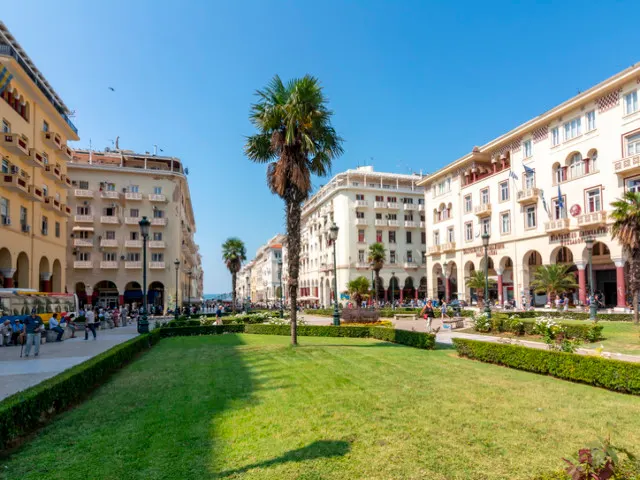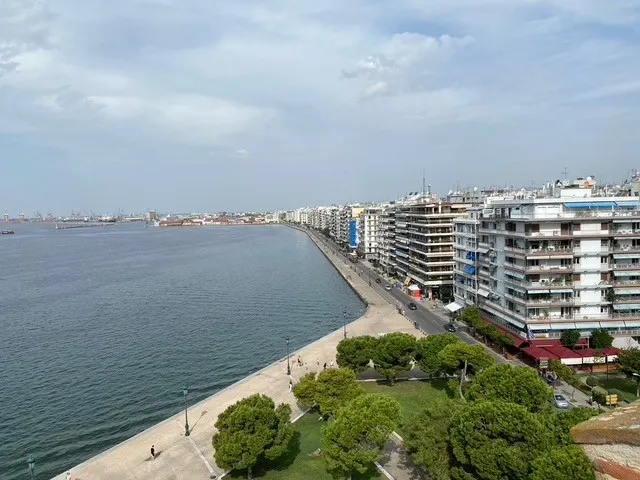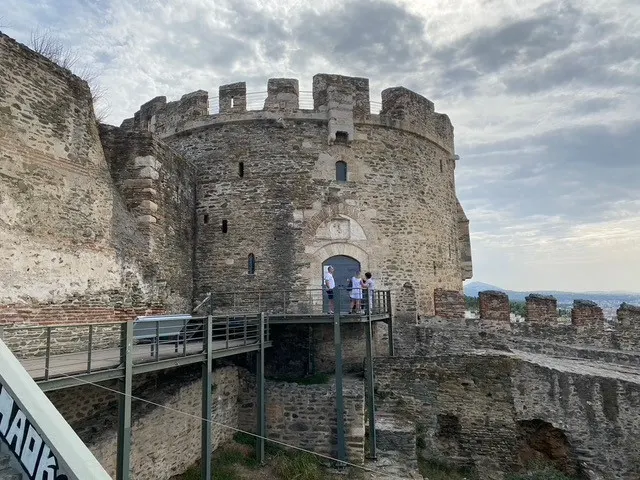When you think about Greece, you are likely first to conjure up images of the Parthenon sitting atop the Acropolis, tall white stone columns, and ancient statues in museums. Or maybe islands set in the deep blue and green Aegean, with sparkling white buildings climbing the steep and rocky shores under a vibrant blue sky and brilliant sunshine.
During our recent trip to Greece, my wife Rita and I wanted to see all that—but we also wanted to get an idea of what it would be like to actually live in Greece, someplace a little less touristy and maybe a little more authentic.
We found the perfect spot for our desires—the city of Thessaloniki in Greece’s northern region of Macedonia.
Although Greece’s largest city and capital, Athens, is about a thousand years older, Thessaloniki dates back to the 3rd century BCE. It is the second largest city, boasting a population of around one million, with about a third of the residents living in the city center. Although it certainly has its share of tourist attractions—even cruise ships visiting regularly—there is a big difference in feel between Athens and Thessaloniki.
Although Athens is the center of the government, there is no escaping the fact that tourism is the number one business in town. On the other hand, Thessaloniki feels more like a working city that just happens to have sites of interest dating back almost 2,400 years.
One factor that may account for this is that Athens went into a major decline in the 1800s after battles with the Turks and the Greek War of Independence. At one point, its population was just 4,000, mostly grouped loosely around the crumbling acropolis.
Although suffering through cycles of invasion and revolution, Thessaloniki also benefited from its position as an important trade hub. Its protected port and access to the Balkans via the rivers Axios and Morava helped keep it an important and thriving city through most of its existence. Even during the Ottoman occupation, which devastated Athens, Thessaloniki’s population actually increased because of continued trade.
During the Byzantine era, Thessaloniki was second only to Constantinople as a center for trade and culture. It was the site of one of the earliest and most important Christian churches during the Roman Empire, having been visited by Paul the Apostle around 50 AD. That first church should be well known to most Bible readers, as the books First and Second Thessalonians are Paul’s letters to the church.
Yet despite its age and rich history, walking around the downtown area seems much like any other modern city—except, of course, with a sprinkling of historic artifacts here and there.
Much of the modern look of the city center is the result of a tragedy. On August 18, 1917, an unattended kitchen fire started a raging inferno that left 72,000 people homeless and destroyed much of the city. Determined to rebuild quickly, the city planners adopted the European-style grid layout for the reconstructed streets and structures.
The result is a city that is a fascinating blend of many eras and cultures. You have cruise ships arriving every day, but also a bustling, working port for business; there are modern buildings, but also ancient walls and historic sites; an old town at the top of the Acropolis, but just down the hill, you find the obvious social and economic impact of youth, owing to the Aristotle University, the largest college in the Balkans.
Touring Around Thessaloniki

In any waterfront town, we like to begin our exploration by walking along the coast. Thessaloniki does not disappoint, with a wide pedestrian walk that runs for miles along the Thermaic Gulf. Our Airbnb was just a few blocks from the port, so it was a pleasant walk down the street between rows of restaurants with outdoor seating and chalkboards proclaiming their specials of the day.
We had barely started when we ran into a marvelous distraction—the Aega Ice Cream Shop, proudly advertising their goat milk ice cream. We, of course, had to stop and sample a few flavors. Turns out goat milk makes for some delicious and creamy treats.
Back on the walkway, we passed benches for admiring the view, periodic steps for accessing the water, and fishermen trying their luck. In the distance, we could see one of our future goals, the White Tower. But since we had arrived in the late afternoon, our objective was to look around a bit and stop to pick up a few supplies.
We turned north and left the water at Aristotelous (Aristotle) Square. This is the gathering place of the city center; a wide, public square used for political speeches and rallies, but also for cultural events and fairs. In fact, there was a fair going on as we arrived, featuring energy-saving devices and electronic vehicles. The square is framed on the north by two quarter-circled and beautiful buildings. One is the five-star Electra Palace Hotel, complemented on the other side of the arc by the Olymion Theatre cinema and bar. Going north from the square are at least five more blocks of parks and green spaces.
City Center Sites

The White Tower of Thessaloniki is the best-known and most visible historic site along the waterfront. Built by the Ottomans in the 15th century, it has served as an observation tower, a fortification, an infamous prison, and finally, now a museum and a great place to get a view of the city.
The first thing you notice about the White Tower is that it is not particularly white. It has been known by many names over the years, like the Lion’s Tower, the Fortress of Kalamaria, and even the grisly Blood Tower during much of the 19th century when it was a place of executions. It was not known as the White Tower until 1890 when a convict struck a bargain; he would whitewash the prison in exchange for his freedom.
Wending your way up the stone steps inside the brick and stone edifice, you must stoop a bit to avoid making contact with the ceiling. On each floor on the 111-foot climb to the top viewing platform, you can take a break and explore displays of the history of the city and the tower. The view from the top is worth the climb. There’s a wonderful 180-degree view of the bay and the waterfront, and you can see parts of the old City Walls at the top of the acropolis.
The entrance fee for the tower is €8, €4 for seniors and students, or during the off-season. Or you can purchase a combo pass to the Tower and three popular museums for €15. The Tower is open every day (except for some holidays) from 8.30 a.m. to 3.30 p.m.—they try to limit the number of people in the Tower at any given time, so you may have to wait a bit if it is crowded.
The Archeological Museum of Thessaloniki is just a short walk from the White Tower, and is one of the best museums of its kind in Eastern Europe. Open from 9 a.m. to 4 p.m. from November to March, and until 10 p.m. the rest of the year, the entrance fee is €8 (€4 during the winter), and it is one of the museums included in the combo pass.
Outside, there is a garden area and open-air exhibits of sarcophagi, stone monuments, altars, living areas from the Imperial era, and more. Inside the museum is an impressive and comprehensive collection of artifacts from the region covering over 200,000 years of history. Metalwork, everyday household tools, jewelry, mosaics, artwork, statues, tombs—even a skeleton on display inside its coffin. Plan to spend an enjoyable few hours in this fascinating museum.
The Museum of Byzantine Culture is also included in the combo pass, with the same entrance fees and hours as the Archeological Museum. As you may guess from the name, this museum deals mostly with the Byzantine Era, displaying works of art and examples of the changing culture of the region. There is a large collection of statues and art from the early Christian church in Macedonia as well.
The Rotunda of Galerius is the last stop on the combo pass. On the walk there, you will pass the Palace of Galerius and The Arch of Galerius. The Rotunda is the oldest church in Macedonia, and when it was built, the Arch was connected to the Rotunda by a road and walkway. They were ordered and built by the 4th-century Roman emperor Galerius around 306 BCE. It is thought that he wanted to use the massive cylindrical Rotunda as his mausoleum, but it began its long history as a polytheist church.
Over the centuries, polytheism gave way to Christian worship, only to be converted to a mosque by the Ottomans in the 16th century, who added a minaret that still stands. When the Greeks gained control of the city again, it became a Greek Orthodox church. Today, it is a historical monument, with digs being conducted around the grounds.
There are over a dozen other museums in Thessaloniki, ranging from a Jewish Museum, the House of Mustafa Kemal Ataturk, an Olympic Museum, a Railway Museum, and even a Pharmacological Museum. There is even their own Agia Sophia, which is not to be confused with the more famous Hagia Sophia in Istanbul. Yet more interesting to us as we walked the streets of the City Center were the number of old and beautiful churches still in service and other remnants of the past.
Everywhere, you see that mix of old and new. The beautiful Burial Monument to Saint Theodorus is just a block from a modern indoor marketplace and across the street from a fish market. There’s a giant brick bath house hidden behind a street of flower vendors, and an upscale bakery and pastry shop on the first floor of an old Roman-style white marble building. There seemed to be something of interest no matter where we wandered in the City Center.
Get Your Free Greece Report Today!
Get Your Free Greece Report Today!
Learn more about a slower pace of life in Greece and other countries in our free daily postcard e-letter. Simply enter your email address below and we'll also send you a FREE REPORT — Retire in Greece—Find Your Dream Retirement in This European Archipelago.

By submitting your email address, you will receive a free subscription to IL Postcards, Overseas Dream Home, The Untourist Daily and special offers from International Living and our affiliates. You can unsubscribe at any time, and we encourage you to read more about our Privacy Policy.
Ano Poli – The Old Town of Thessaloniki

North of the City Center at the top of the hill is the Old Town, also called Ano Poli or Upper Town. This used to be the main Ottoman Quarter, as well as the home of a large part of the Jewish community. It is a fascinating contrast to the city at the foot of the hill, with cobblestone and brick streets, stone houses, and pastel-colored shops and restaurants.
Since this area escaped the fire of 1917, it still has a labyrinth of streets that look like a place out of time. Stone homes seem to cling to the steep streets, and alleys suddenly become precipitous stairways down to the next level of homes and shops. This is where you can still find sections of the city's ancient walls that once ran from the Trigonio Tower on the hilltop down to the White Tower.
The views from the Ano Poli are just incredible. You can look out at the entire city spread below you and see the deep blue and green waters of the Thermaic Gulf as it gives way to the Aegean. On a clear day, you can see Mount Olympus rising in the background. It is in the Ano Poli that you feel what life may have been like hundreds of years ago, and it truly feels like an authentic Greek village, set apart from the city.
There are historic points of interest, of course, including the former home of Kemel Attaturk and Byzantine churches. What we enjoyed most, however, was the quiet and peaceful Vlatadon Monastery. After greeting two donkeys penned near the front entrance, we walked through the gates and into another world. All around us was serene and green. The walls block the sounds of the city, so all we could hear was birdsongs. As we explored the buildings and grounds, passing dozens of cats stretched out and lounging in the sun, it was hard to believe that we were just a mile or two from the vibrant City Center.
If you visit the Ano Poli, I recommend you do what we did: take a taxi to the top of the hill and save yourself some sweat and effort. It was quite pleasant to stroll about the town on foot, and walking back down the hill, we were able to follow sections of the old city walls all the way down to Aristotle University and back to the 21st century.
Does Thessaloniki Have Expat Potential?
We met an expat while we were walking around town, a former military person making Thessaloniki her home. She told us there were a few expats around, and a lot of foreign nationals because of the University. Prices around town for groceries and meals were generally a little less than what you would pay in the States. According to the Numbeo website, the cost of living is about 14% lower than where we are based in east Tennessee. Rents, however, are an estimated 70.7% lower. I found apartments ranging from €450 to €1200 for rent, depending on size and location, so a couple should be able to live nicely on around $2,000/month.
It was not an expensive visit either, as our Airbnb (one-bedroom, full kitchen, living and dining room, balcony, bath, and washing machine in a great location) costs us only about $60/night with cleaning and service fees included.
Thessaloniki is easy to get to, either by cruise ship or from Athens via rail or airline. Our one-way flight from Athens was just $89 for the two of us—actually cheaper than the trains, which would have cost about $150 for two.
Would we live there? Probably not, but mostly because while we enjoy visiting larger cities, we don’t really want to live in one. But I can say that in Thessaloniki, we felt quite comfortable and safe as we traveled around town, and we enjoyed some wonderful little local restaurants with outside dining under the trees. The locals we spoke to were all friendly and helpful, and we had no language difficulties despite our knowledge of Greek being limited mostly to “thank you” and “hello.” Even most signs around the city were in English or had English words beneath the Greek. We would definitely recommend that if you are going to visit Athens, you plan to take some time to experience a different view of Greece in Thessaloniki.
